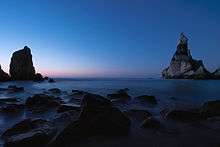Blue hour

The blue hour (from French l'heure bleue)[1][lower-alpha 1] is the period of twilight in the morning or evening, during the civil and nautical stages, when the Sun is at a significant depth below the horizon and residual, indirect sunlight takes on a predominantly blue shade.
When the sky is clear, the blue hour can be a colorful spectacle, with the indirect sunlight tinting the sky yellow, orange, red, and blue. This effect is caused by the relative diffusibility of shorter wavelengths (bluer rays) of visible light versus the longer wavelengths (redder rays). During the blue "hour", which typically lasts roughly 20 minutes (depending on latitude), red light passes through space while blue light is scattered in the atmosphere, and thus reaches Earth's surface.
Many artists value this period for the quality of the soft light. Although the blue hour does not have an official definition, the blue color spectrum is most prominent when the Sun is between 4° and 8° below the horizon.[2]
See also
Notes
References
- ↑ Verfaillie, Roland (2011). L'heure Bleue. San Francisco: Purple Onion Press. p. 5.
- ↑ "Blue Hour – Magic Hour". timeanddate.com. Retrieved 16 October 2017.
External links
| Wikimedia Commons has media related to Blue hour. |
- Blue hour mobile application (iOS, Iphone/iPad)
- bluehoursite.com: Everything about Blue Hour and Night Photography (news, articles, tips and calculator)
- Twilight Calculator, Golden Hour/Blue Hour table
